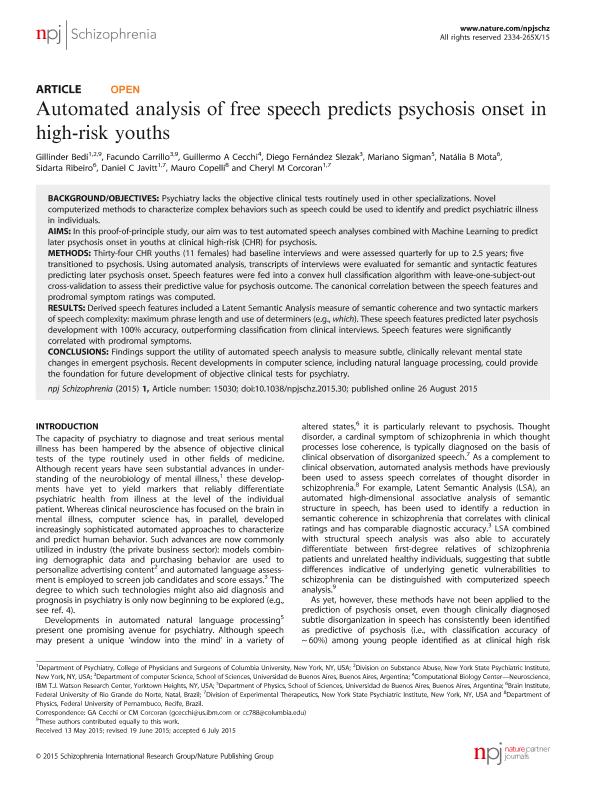Mostrar el registro sencillo del ítem
dc.contributor.author
Bedi, Gillinder
dc.contributor.author
Carrillo, Facundo

dc.contributor.author
Cecchi, Guillermo Alberto

dc.contributor.author
Fernandez Slezak, Diego

dc.contributor.author
Sigman, Mariano

dc.contributor.author
Mota, Natália
dc.contributor.author
Ribeiro, Sidarta
dc.contributor.author
Javitt, Daniel
dc.contributor.author
Copelli, Mauro
dc.contributor.author
Corcoran, Cheryl
dc.date.available
2018-05-09T17:47:53Z
dc.date.issued
2015-08
dc.identifier.citation
Bedi, Gillinder; Carrillo, Facundo; Cecchi, Guillermo Alberto; Fernandez Slezak, Diego; Sigman, Mariano; et al.; Automated analysis of free speech predicts psychosis onset in high-risk youths; Nature Publishing Group; npj Schizophrenia; 1; 8-2015
dc.identifier.issn
2334-265X
dc.identifier.uri
http://hdl.handle.net/11336/44639
dc.description.abstract
BACKGROUND/OBJECTIVES: Psychiatry lacks the objective clinical tests routinely used in other specializations. Novelcomputerized methods to characterize complex behaviors such as speech could be used to identify and predict psychiatric illnessin individuals.AIMS: In this proof-of-principle study, our aim was to test automated speech analyses combined with Machine Learning to predictlater psychosis onset in youths at clinical high-risk (CHR) for psychosis.METHODS: Thirty-four CHR youths (11 females) had baseline interviews and were assessed quarterly for up to 2.5 years; fivetransitioned to psychosis. Using automated analysis, transcripts of interviews were evaluated for semantic and syntactic featurespredicting later psychosis onset. Speech features were fed into a convex hull classification algorithm with leave-one-subject-outcross-validation to assess their predictive value for psychosis outcome. The canonical correlation between the speech features andprodromal symptom ratings was computed.RESULTS: Derived speech features included a Latent Semantic Analysis measure of semantic coherence and two syntactic markersof speech complexity: maximum phrase length and use of determiners (e.g., which). These speech features predicted later psychosisdevelopment with 100% accuracy, outperforming classification from clinical interviews. Speech features were significantlycorrelated with prodromal symptoms.CONCLUSIONS: Findings support the utility of automated speech analysis to measure subtle, clinically relevant mental statechanges in emergent psychosis. Recent developments in computer science, including natural language processing, could providethe foundation for future development of objective clinical tests for psychiatry.npj Schizophrenia (2015) 1, Article number: 15030; doi:10.1038/npjschz.2015.30; published online 26 August 2015
dc.format
application/pdf
dc.language.iso
eng
dc.publisher
Nature Publishing Group

dc.rights
info:eu-repo/semantics/openAccess
dc.rights.uri
https://creativecommons.org/licenses/by/2.5/ar/
dc.subject
Schizophrenia
dc.subject
Neuroscience
dc.subject.classification
Ciencias de la Computación

dc.subject.classification
Ciencias de la Computación e Información

dc.subject.classification
CIENCIAS NATURALES Y EXACTAS

dc.title
Automated analysis of free speech predicts psychosis onset in high-risk youths
dc.type
info:eu-repo/semantics/article
dc.type
info:ar-repo/semantics/artículo
dc.type
info:eu-repo/semantics/publishedVersion
dc.date.updated
2018-05-04T21:32:26Z
dc.journal.volume
1
dc.journal.pais
Estados Unidos

dc.description.fil
Fil: Bedi, Gillinder. Columbia University; Estados Unidos. New York State Psychiatric Institute; Estados Unidos
dc.description.fil
Fil: Carrillo, Facundo. Consejo Nacional de Investigaciones Científicas y Técnicas; Argentina. Universidad de Buenos Aires. Facultad de Ciencias Exactas y Naturales. Departamento de Computación; Argentina
dc.description.fil
Fil: Cecchi, Guillermo Alberto. Ibm Research. Thomas J. Watson Research Center; Estados Unidos
dc.description.fil
Fil: Fernandez Slezak, Diego. Consejo Nacional de Investigaciones Científicas y Técnicas; Argentina. Universidad de Buenos Aires. Facultad de Ciencias Exactas y Naturales. Departamento de Computación; Argentina
dc.description.fil
Fil: Sigman, Mariano. Consejo Nacional de Investigaciones Científicas y Técnicas; Argentina. Universidad de Buenos Aires. Facultad de Ciencias Exactas y Naturales. Departamento de Física; Argentina
dc.description.fil
Fil: Mota, Natália. Universidade Federal do Rio Grande do Norte; Brasil
dc.description.fil
Fil: Ribeiro, Sidarta. Universidade Federal do Rio Grande do Norte; Brasil
dc.description.fil
Fil: Javitt, Daniel. Columbia University; Estados Unidos. New York State Psychiatric Institute; Estados Unidos
dc.description.fil
Fil: Copelli, Mauro. Universidade Federal de Pernambuco; Brasil
dc.description.fil
Fil: Corcoran, Cheryl. Columbia University; Estados Unidos. New York State Psychiatric Institute; Estados Unidos
dc.journal.title
npj Schizophrenia
dc.relation.alternativeid
info:eu-repo/semantics/altIdentifier/doi/http://dx.doi.org/10.1038/npjschz.2015.30
dc.relation.alternativeid
info:eu-repo/semantics/altIdentifier/url/https://www.nature.com/articles/npjschz201530
Archivos asociados
